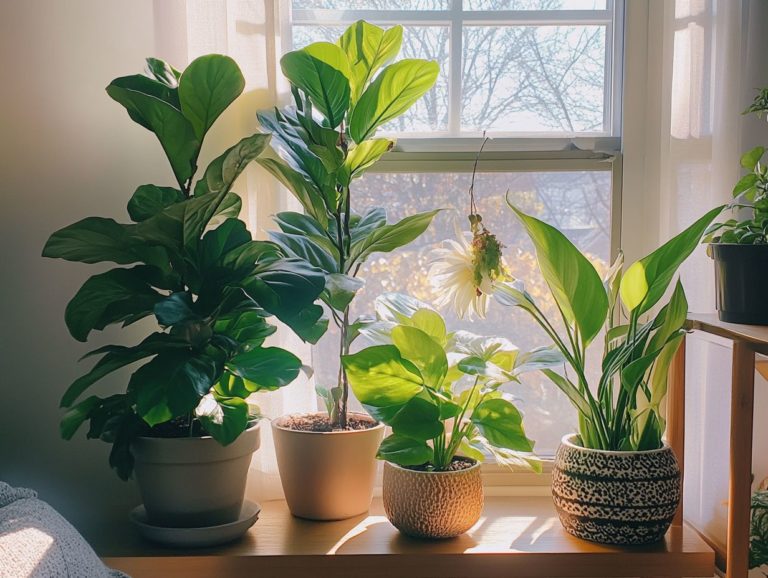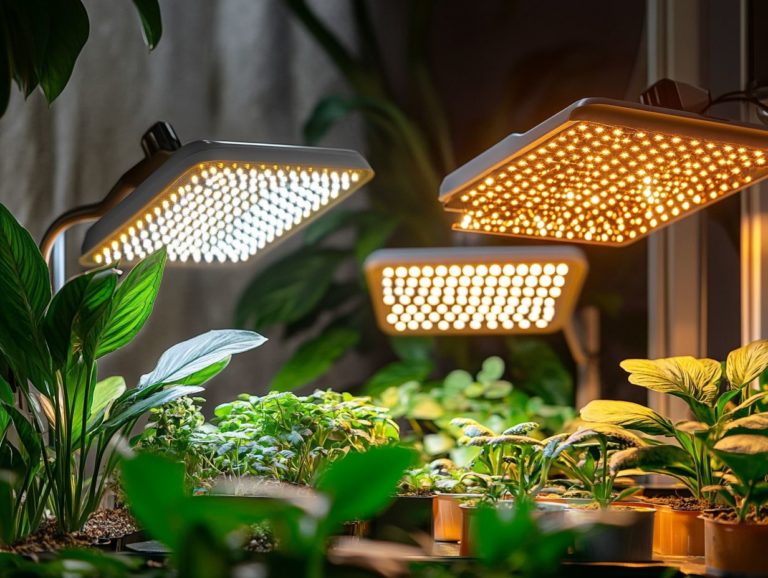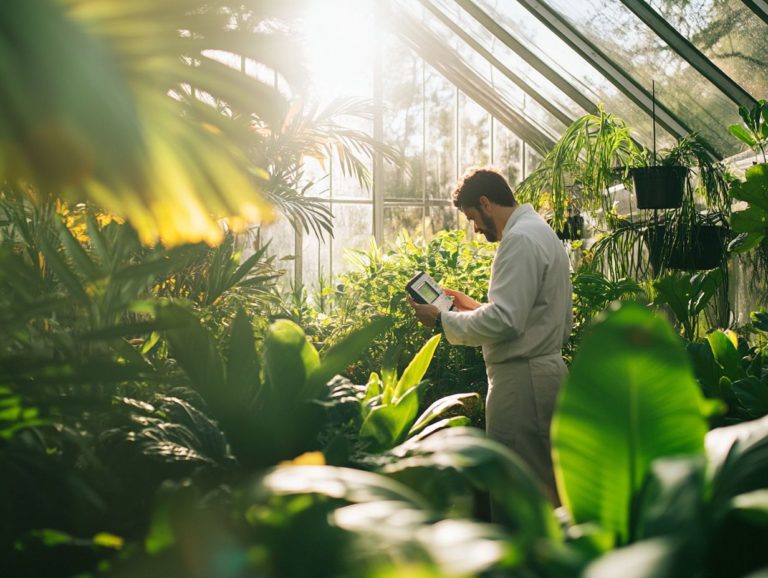Lighting Tips for Indoor Herb Gardens
Growing herbs indoors enhances the flavor of your meals and infuses your home with a refreshing touch of greenery.
Vibrant herb growth in your indoor garden largely depends on proper lighting. This article delves into essential lighting elements for indoor herb gardens, exploring various options and guiding you on selecting the best fit for your plants.
You ll discover specific lighting requirements for different herbs, along with practical tips for setup and maintenance strategies. These tips will ensure your indoor garden flourishes, especially when considering artificial light and light exposure.
Prepare to illuminate your herb-growing journey and watch your culinary creations come to life!
Contents
- Key Takeaways:
- Choosing the Right Lighting for Herb Gardens
- Lighting Techniques for Different Herbs
- Tips for Setting Up Lighting in Your Indoor Herb Garden
- Maintaining Optimal Lighting for Healthy Herb Growth
- Frequently Asked Questions
- What are the best lighting tips for indoor herb gardens?
- Which type of artificial light is best for indoor herb gardens?
- How long should I leave the lights on for my indoor herb garden?
- Can I use natural sunlight for my indoor herb garden?
- How close should the lights be to my indoor herb garden?
- What should I do if my herbs are not getting enough light?
Key Takeaways:

- Select lighting that fits your indoor herb garden s needs by considering natural vs. artificial light, intensity, and duration.
- Research the specific lighting techniques for each herb in your garden.
- Proper positioning and timing of lighting impact the health and growth of your indoor herbs.
Benefits of Growing Herbs Indoors
Growing herbs indoors offers numerous benefits. Fresh herbs at your fingertips elevate your cooking and bring a burst of flavor!
You can control light exposure for optimal growth, boosting essential oil production. Your indoor garden can thrive regardless of the weather outside, creating a perfect sanctuary for cultivating herbs like basil, rosemary, and mint.
With attentive care, you can avoid common nutrient deficiencies and promote healthy growth while enjoying the delightful aesthetics of lush greenery in your home.
An indoor herb garden can transform everyday meals into culinary delights, making them healthier and tastier. The controlled environment allows you to use grow lights that mimic natural sunlight, making success within reach even for novice gardeners.
Herbs like parsley and chives not only add vibrant greens to your kitchen but also enhance your indoor air quality. Nurturing these plants can become a soothing hobby, turning your living area into a serene oasis filled with fragrance and life.
Choosing the Right Lighting for Herb Gardens
Selecting the right lighting for your herb garden is essential for fostering optimal growth. Each herb has unique light requirements that can greatly influence its development.
Indoor lighting systems, such as LED lights and compact fluorescent options, can effectively mimic the natural sunlight that herbs like oregano and parsley thrive on. For more insights, refer to the best light arrangements for houseplants. Understanding the specific light intensity and duration each herb needs helps create an ideal indoor environment that boosts photosynthesis and promotes robust plant health.
Types of Lighting Options
You ll find various lighting options for indoor herb gardens, each offering unique benefits. LED lights are efficient, delivering optimal light exposure with a spectrum of blue and red light that your herbs crave.
Compact fluorescent lights are also popular due to their low energy consumption while still providing sufficient light for growth. Each lighting type has its advantages and disadvantages.
While LED lights have a longer lifespan and the ability to be fine-tuned for specific light spectrums, they often come with a higher upfront cost. On the other hand, compact fluorescent lights are budget-friendly but require more frequent replacements and can generate heat, posing a risk to your delicate plants.
High-intensity discharge lights shine brightly in larger setups but can lead to higher energy bills. Weighing these factors carefully will guide you in choosing the best lighting for your indoor herb garden, including using sunlight for indoor plants effectively, ensuring your plants flourish with the light exposure they need.
Factors to Consider When Choosing Lighting
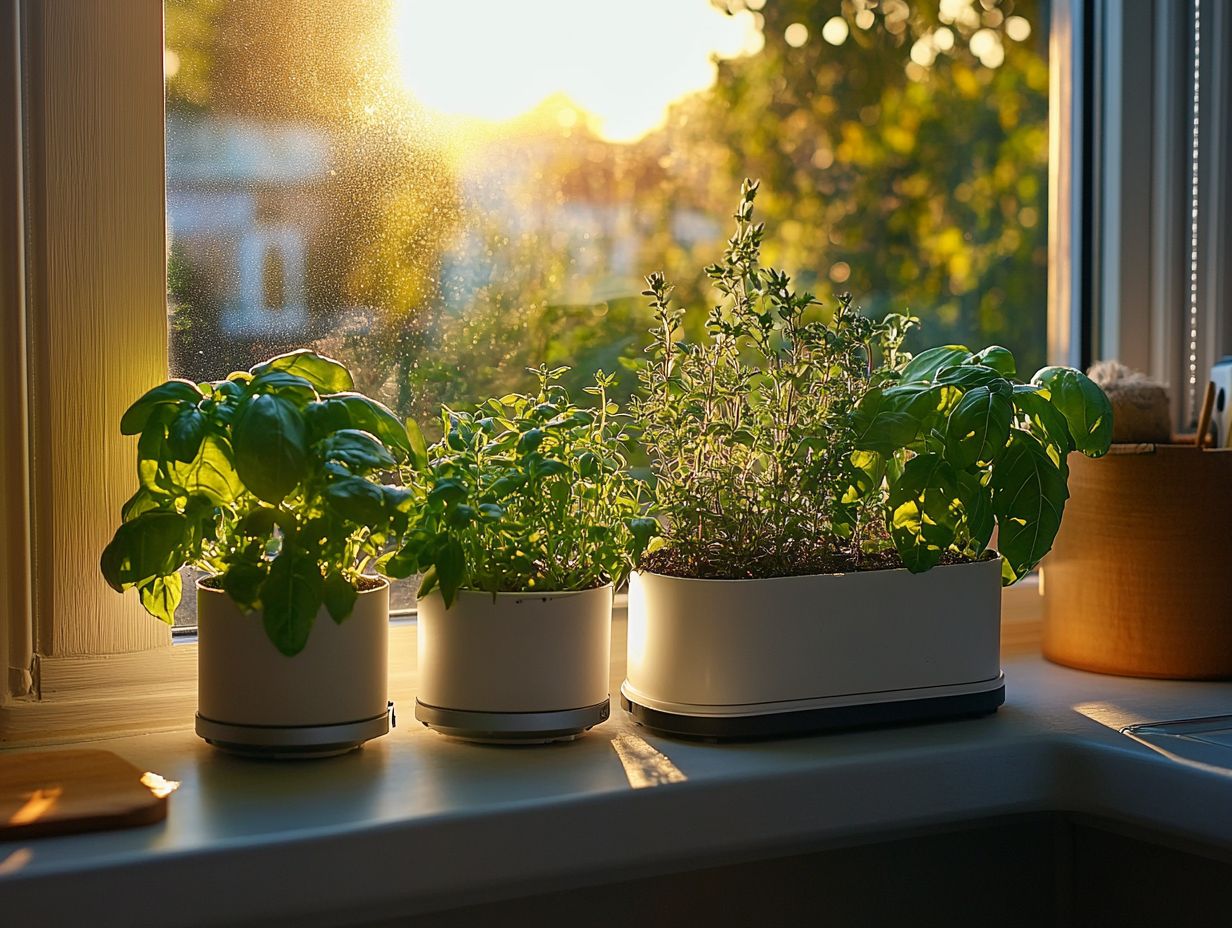
When selecting lighting for your indoor herb garden, consider several key factors to create the ideal conditions for your herbs to thrive.
Light intensity is vital. Plants like mint and thyme have specific light needs that can change depending on their growth stage. Understanding how light exposure influences soil drainage and overall plant growth helps establish a balanced environment that nurtures your herbs.
The duration of light exposure is equally important. Herbs benefit from a consistent cycle of light and darkness, typically requiring about 12 to 16 hours of light each day. The spectrum of light is crucial for photosynthesis, impacting everything from leaf development to flavor potency.
Choosing the right type of lighting such as LED (Light Emitting Diode, energy-efficient) or fluorescent lights (which use gas to produce light) ensures efficiency and promotes healthy growth. For more insights, check out these tips for effective plant lighting. Also, consider how your setup affects humidity and temperature in the growing space; these factors can significantly influence your herb garden’s success.
Lighting Techniques for Different Herbs
Grasping the unique lighting needs of various herbs is essential for cultivating a thriving indoor garden. For example, basil grows well with high light exposure, needing about 12-16 hours of artificial light daily.
In contrast, herbs like rosemary and oregano flourish under slightly less intense lighting. Tailoring your lighting techniques can unlock the full potential of your herbs!
Specific Lighting Needs for Different Herbs
Understanding the specific lighting needs of various herbs is crucial for a flourishing indoor garden. For instance, basil thrives in full sun and requires about 14-16 hours of artificial light. In contrast, rosemary prefers a more subdued lighting environment, managing well with just 10-12 hours.
Then there’s parsley, which grows well under moderate light conditions, needing around 12-14 hours to develop vibrant, lush leaves. Mint thrives in bright, indirect light, and about 12-14 hours will maximize its delightful aroma. Thyme and oregano are adaptable, flourishing with slightly less light, needing around 8-10 hours while still delivering robust flavors.
For optimal growth, consider investing in fluorescent or LED grow lights. These options simulate sunlight effectively while ensuring efficient energy usage and heat control, resulting in lush foliage and heightened flavor for your culinary herbs. Additionally, following tips for keeping indoor plants thriving can further enhance your plant care routine.
Tips for Setting Up Lighting in Your Indoor Herb Garden
Setting up effective lighting in your indoor herb garden requires careful consideration of both positioning and timing. Place your LED lights or compact fluorescent bulbs at the right distance from the herbs to ensure maximum light intensity while preventing any potential damage.
Timing the duration of light exposure is important. It greatly influences their growth and overall health, ensuring they receive adequate sunlight exposure.
Don’t wait set up your lighting today to enjoy a thriving herb garden!
Positioning and Timing
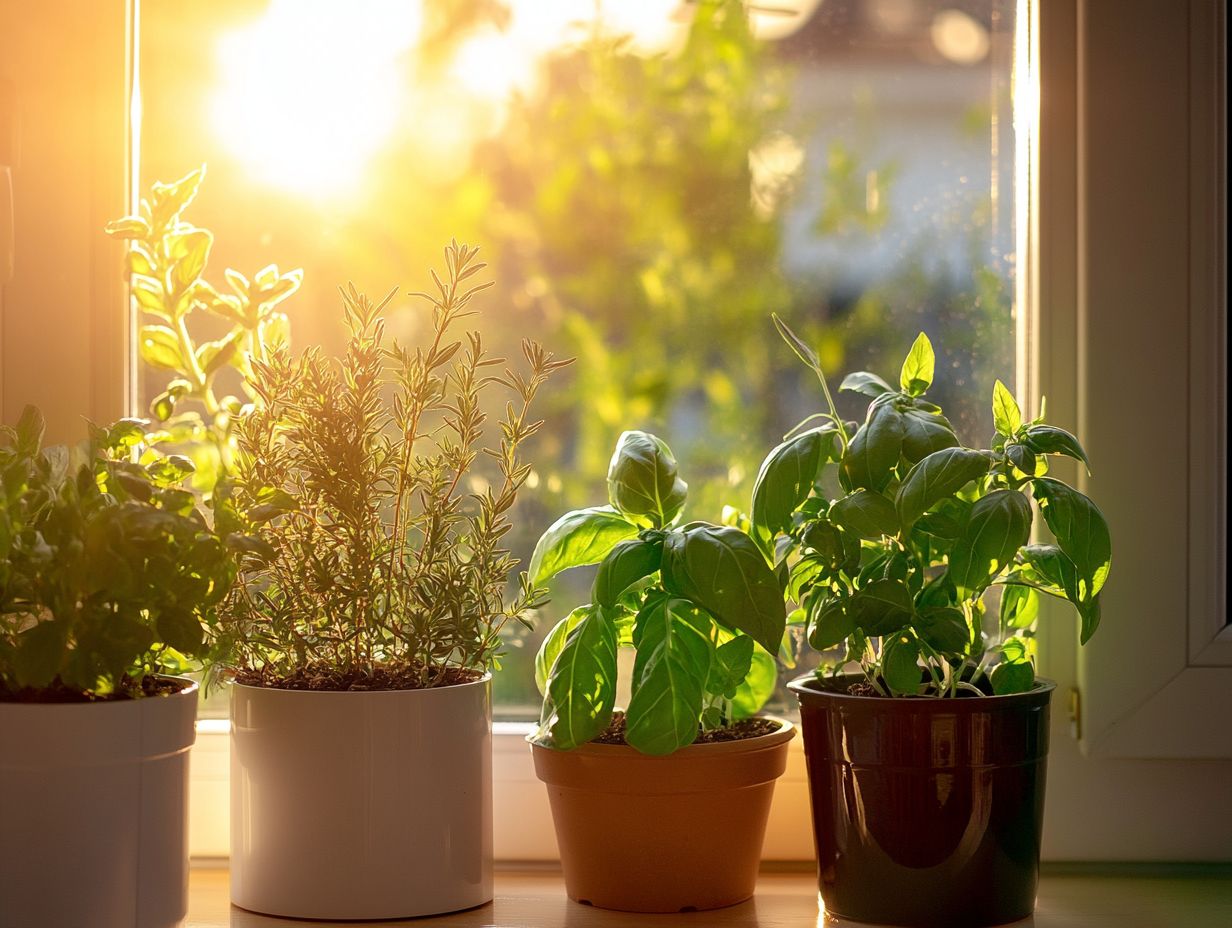
Proper positioning and timing of your indoor lighting are essential for ensuring your plants receive adequate light exposure to flourish. Adjust the lights to the right height to control light intensity and prevent your plants from becoming leggy. This way, they can enjoy the full spectrum of UV light that supports photosynthesis.
Remember, different herbs have unique light requirements. For example, basil thrives on 12 to 16 hours of light each day, while parsley may be content with around 10 hours.
Using timers automates the light cycle, mimicking natural daylight and supporting crucial growth phases. Tailor the distance between the light source and your plants based on the type of lamp you re using; typically, LED lights need more space than fluorescent bulbs.
Keep a close eye on how your plants respond to the light. Watch for signs that your plants need more light, such as slower growth and pale leaves. Consider using light shades for indoor plants to enhance their exposure. By fine-tuning these elements, you’ll create an optimized environment perfect for cultivating robust herbs.
Maintaining Optimal Lighting for Healthy Herb Growth
Maintaining optimal lighting for your indoor herb garden is an ongoing task that requires regular attention and adjustments to promote healthy plant growth. Seasonal variations in natural light, the growth phases of your herbs, and various environmental conditions may require changes to your lighting setup.
By staying aware of these factors, you can effectively manage light exposure, ensuring your indoor garden thrives and flourishes with vitality. For more detailed information, check out understanding indoor plant light needs.
Monitoring and Adjusting Lighting as Needed
Monitoring and adjusting lighting as needed is vital for providing your herbs with the right amount of light during their growth cycle. Regularly check the health and size of your plants. If it s time to tweak the light intensity or duration, do it to support optimal soil drainage and overall plant vitality.
To effectively track your indoor garden’s lighting situation, pay attention not only to the growth rate but also to the color and quality of your plants’ leaves. If you notice yellowing leaves, it could mean they aren’t getting enough light. Conversely, stunted growth might suggest they’re getting too much. A lux meter, a device that measures light intensity, can be a valuable tool for fine-tuning your setup for the best results.
If your plants start looking leggy, reposition your light source or invest in adjustable LED grow lights that allow for changes in both height and intensity. Establishing a consistent light schedule tailored to the specific needs of each herb is crucial for promoting healthy, robust growth.
Frequently Asked Questions
What are the best lighting tips for indoor herb gardens?

Indoor herb gardens need at least 6-8 hours of light per day to thrive. Use fluorescent or LED lights and position them about 6 inches above the plants.
Which type of artificial light is best for indoor herb gardens?
Fluorescent and LED lights are the best options for indoor herb gardens. They provide the right spectrum of light and are energy efficient.
How long should I leave the lights on for my indoor herb garden?
Keep lights on for 12-16 hours daily to mimic natural daylight. Don’t forget to give your plants a break from light by turning them off at night.
Can I use natural sunlight for my indoor herb garden?
Yes, natural sunlight can be used for indoor herb gardens. However, ensure that the plants aren t getting too much direct sunlight, as it can cause heat stress. Use sheer curtains to filter the light or place the plants in a spot with indirect sunlight.
How close should the lights be to my indoor herb garden?
The lights should be about 6 inches above the plants to ensure they are getting enough light without overheating or being too far away to be effective.
Start adjusting your indoor lighting today for healthier herbs!
What should I do if my herbs are not getting enough light?
Are your herbs not getting enough light? Brighten their day by using artificial lights or moving them to a sunnier spot!
Don’t forget to turn your plants! This helps them soak up light evenly.

